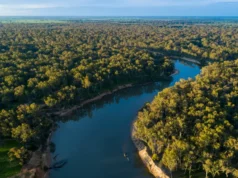Photo credit: Ricky French
As far as accommodation options go, Asbestos Cottage is unlikely to end up on any New Zealand tourism brochures. A good thing, too, as we’ll be staying there in a couple of weeks and like its once long-term residents Annie and Henry Chaffey we’d like the place to ourselves.
The couple lived as recluses in the small, timber cottage on a hillside near the Takaka River at the top of the South Island between 1914 and 1951. They were both fleeing unhappy marriages, and the isolated miners’ cottage provided an escape from society’s judgement. Their story is surreally told in the 1981 book by Jim Henderson, The Exiles of Asbestos Cottage. Henderson writes as though he’s swallowed a dictionary, a generous handful of prescription drugs, and washed it all down with a powerful hallucinogenic. New Zealand’s Manning Clark, perhaps.
Henderson wrote to soothe the crippling PTSD he suffered as a result of his time in the Second World War. He had a fascination with the lives of unsung country folk, and he brought the dreams, dramas and downright weirdness of rural New Zealand to life through his books and broadcasts, and nowhere more so than in this book. It’s a good effort considering all of Annie’s letters (and most of Henry’s) were burnt or lost, so all he has to go on are interviews with visitors who tramped through the beech forest to call on the hideaway couple over the decades.
Their far-flung, solitary existence made me think of Tasmania’s Deny King, who lived with his wife and children in Melaleuca. We know a lot more about Deny King than we do about Henry Chaffey. Chaffey was an anti-authoritarian rebel who couldn’t get on with people, so it was a good thing he was a brilliant bushman. He left the cottage for weeks at a time to mine and hunt, but always returned home to Annie at the agreed day and time. According to Henderson Henry sometimes slept with explosives under his armpits, which he describes as an “endearing whim.” Alas we don’t hear if Annie shared this summation of his eccentric predilection.
Annie was a proud Edwardian lady who didn’t seem to notice she was living as a hermit in a shack in the middle of a vast nowhere. When visitors arrived she wouldn’t let them enter until she changed into a neck to ankle dress and got out the white damask table napkins. Although happy to entertain, she resisted private questions or any entreats to reveal her motivation or state of mind throughout her life at Asbestos Cottage. She must have suffered great loneliness, though. When a friend carried her baby boy to the cottage on one occasion it brought her to tears. She hadn’t seen a baby in over twenty years. She was 35 when she arrived at the cottage, and she left behind her two teenage sons. Annie’s friend Phyllis Wilkins tells Henderson, “There must have been something – you wonder what – to have driven her to it, being such a fine person. To me, it seems so strange, to go, and to more or less bury yourself.” The answer, as sad and common then as it is today, was domestic violence.
Henderson finds no evidence of Annie having hobbies (“…but she shared Henry’s interest and belief in asbestos”). Henry took meticulous rainfall levels and drank a lot of whisky. In the late 1970s Henderson walks through the Annie and Henry’s bedroom where, “New Zealand’s most sombre wallpaper remains. A patch covered with pages of old mining journals.”
A visit to the bedroom that holds New Zealand’s most sombre wallpaper awaits. I want to see the hearth where Annie sat the camp oven and feel the isolation of the mountain home. I have the feeling there’s a lot more to the story of the exiles of Asbestos Cottage. I’m only a quarter of the way through the book. A sad love story, heading for tragedy, a masterful travel guide. Lonely planet.



